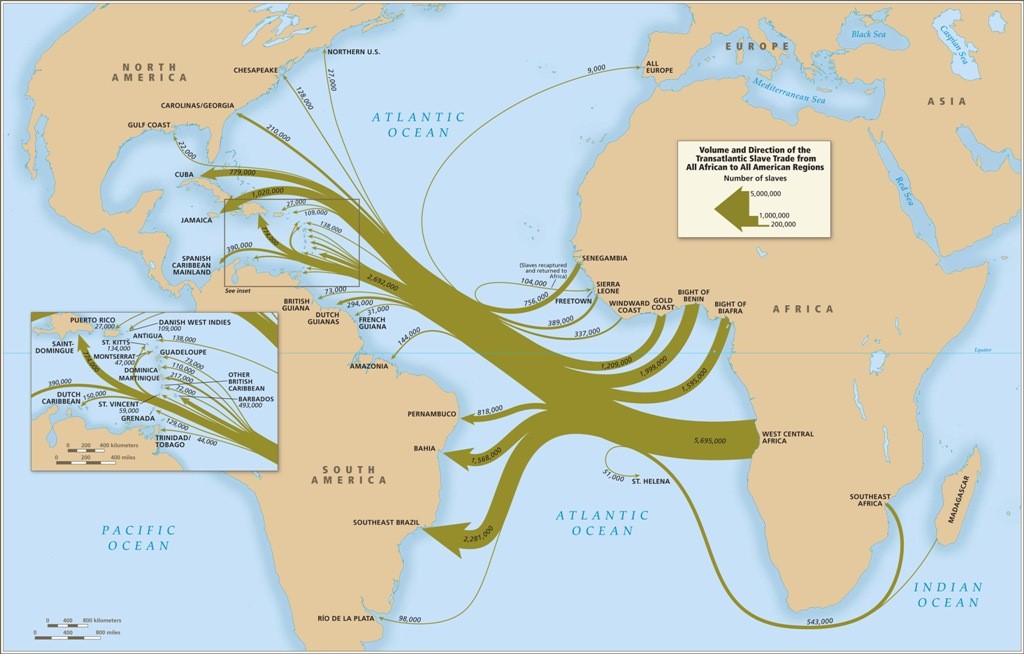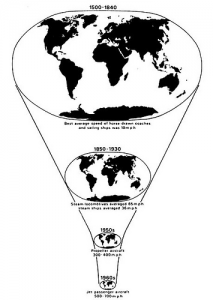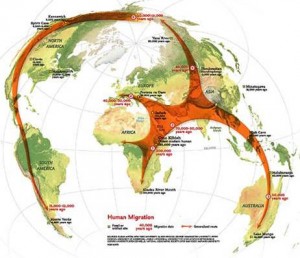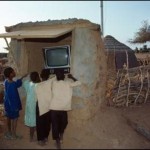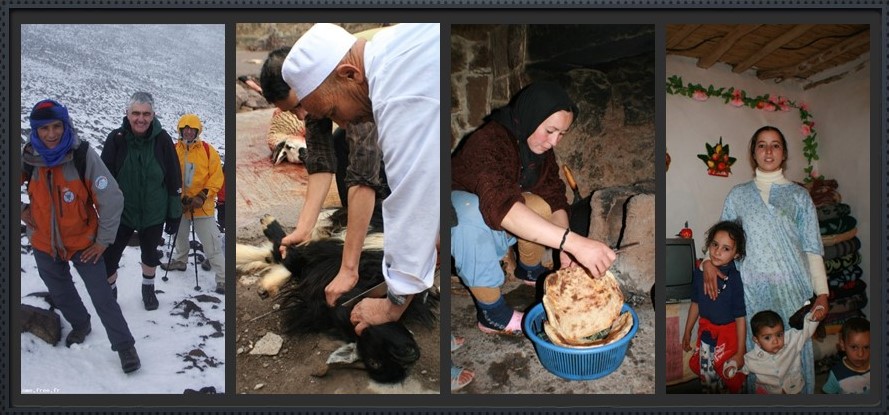The people and cultures connected to Africa have played a key role in the development of humanity throughout the world. From the first band of people to leave the continent and begin populating the planet more than 50,000 years ago to the worldwide popularity of coffee, African people and cultures have played a key role in shaping the world that we live in today. This is important because when we address the many ways that global Africanisms are significant to people living throughout the world we can develop a greater understanding of the ways that African people and cultures are relevant to everyone. This lesson will provide a brief overview of the globalization of African Culture.
Lesson Objectives
- define globalization, diaspora, and Pan-Africanism
- describe how communication and transportation technologies contribute to globalization processes in Africa
- evaluate how global flows interact with local circumstances to create unique cultural forms
- present an example of ‘glocalization’ in Africa
Globalization and the African Diaspora
The phrase African diaspora gradually entered common usage at the turn of the 21st century. The term diaspora originates from the Greek διασπορά (diaspora, literally “scattering”), and the African Diaspora refers to the global collection of communities comprised of peoples and cultures connected to Africa. The African Union (AU) defines the African diaspora as “people of native African origin living outside the continent, irrespective of their citizenship and nationality and who are willing to contribute to the development of the continent and the building of the African Union”. The term also refers to the descendants of the West and Central Africans who were enslaved and shipped to the Americas via the Atlantic slave trade between the 16th and 19th centuries, with their largest populations in Brazil, the United States and Haiti. African diaspora also refers to the more recent (voluntary) mass emigration of African people to Europe, Asia and the Americas seeking employment, amnesty and/or a better way of life.
The global dispersion of African people and African cultures transformed, and continues to shape, cultural landscapes worldwide as African peoples and cultures interact and engage with cultural communities outside of Africa. People carry culture, and this means that a variety of African foods and cooking techniques, languages, art, religion, dance, folklore, music and other forms of expression spread worldwide. The blending of African culturalisms with cultural beliefs and practices outside of Africa has created a variety of new and diverse cultural practices throughout the world. In this way, African culture shapes and is shaped by globalization processes.
Globalization
While scholars and academics have yet to agree on a precise definition for the term globalization, most agree that the term refers to ever-increasing contact between people throughout the world (Held et al 2005). People often use the term ‘globalization’ when they refer to the global economic restructuring, such as the development policies and programs introduced in the Modernization and Development lesson. The global economy is undoubtedly a product of globalization, yet globalization also encompasses social, cultural, ideological and biological exchanges as well. These world-wide exchanges are made possible by what David Harvey refers to as time-space compression.
Time-Space Compression
In his book, The Condition of Post-Modernity (1995), Harvey explains that time-space compression is the result of technological advances in communication and transportation technologies that accelerate the rate of exchange between people across vast distances. What this means is that through technology, the amount of time it takes for people to interact across the same distance is decreased, or compressed. Faster exchange times leads to a greater amount of social interconnectedness. Greater interconnectedness accelerates the rate of cultural change because culture is dynamic; culture changes as people adapt to new circumstances. Similarly, Doreen Massey describes time-space compression and its effect on society as “speeding up” and “spreading out” as time-space compression becomes more prevalent through rapid internationalization. Cultures and communities merged during time-space compression due to rapid growth and change, as “layers upon layers” of histories fuse together to shift our ideas of what the identity of a “place” should be.
Theorists generally identify two historical periods in which time–space compression is most prevalent:
- The period from the mid-19th century to the beginnings of the First World War when innovations and inventions such as the telegraph and telephone (communication) and the combustible engine and aeronautics (transportation) dramatically increased the rate of exchange.
- The end of the 20th century when digital technologies such as email and digital banking along with the rapid increase in international tourism further accelerated global exchanges.
Interaction & Exchange
Although globalization is oftentimes characterized as a 21st century phenomenon, many scholars argue that globalization began when humans initiated the first migration out of Africa more than 50,000 years ago. As people began to colonize different environments throughout the world, they developed new adaptive cultural forms which they shared with neighbors, who shared with their neighbors, and so on. In his book, Europe and the People without History (1995), Eric Wolf shows how technologies and ideas were shared throughout the early trade routes that connected civilizations and cultures long before European colonialism came to dominate the world system. As people moved and interacted along trading routes connecting Africa, Europe, Asia and the Americas, they not only carried and exchanged goods and services, they also engaged in social, cultural, ideological and biological (reproduction and/or communicable diseases) exchanges.
The Network Society
Today, digital technologies have revolutionized world-wide social relations and led to the creation of a global village. In his three-part work, The Rise of the Network Society (2005), Manuel Castells outlines how key social structures and institutions in the 21st century are becoming organized around electronically processed information networks such as internet and cellular communication. These networks have substantially modified, and even undermined, existing networks for production, experience, power, and culture.
The power of networks was demonstrated by the use of social media, such as Facebook and Twitter, during the Arab Spring uprising by protestors in North Africa who were able to connect with and garner support from a global audience. Today, the ever-increasing popularity of online dating networks which are rapidly becoming the primary platform for romantic and sexual encounters between individuals across vast distances – even those living in remote villages. Another example is the ways that exchange and barter systems that distribute tangible money resources have given way to digital financing and banking systems that are built on the exchange of intangible monetary wealth. Advances in communication and transportation networks has dramatically altered the way people interact with one another and transformed social relationships. Networks have touched virtually every aspect of social relations, as even people living in the most remote and rural areas of the world are linked into the network via satellite television networks and internet communications.
Globalization & Power
Globalized exchanges are embedded in systems of power and inequality at the local level to the global arena. In the Households and Families section in the next module, we will explore the ways that inequality inside the household can lead to unequal access to resources for certain people in the household, this includes access to communication and transportation resources. The same can be said in rural versus urban areas, or among people of different racial, ethnic, religious or national affiliations. In addition, a country’s political and economic conditions can affect citizens’ access to technology. Because of this, globalization happens unevenly and uneven globalization leads to social fracturing and even conflict.
Disjuncture & Difference
Globalization has frequently been described as a homogenizing phenomenon, a process where everything and everyone is becoming the same. Yet, research on globalization has shown that uneven globalization is actually contributing to the proliferation of difference among people living in the same community, even within the same household. This is because change does not occur evenly, and
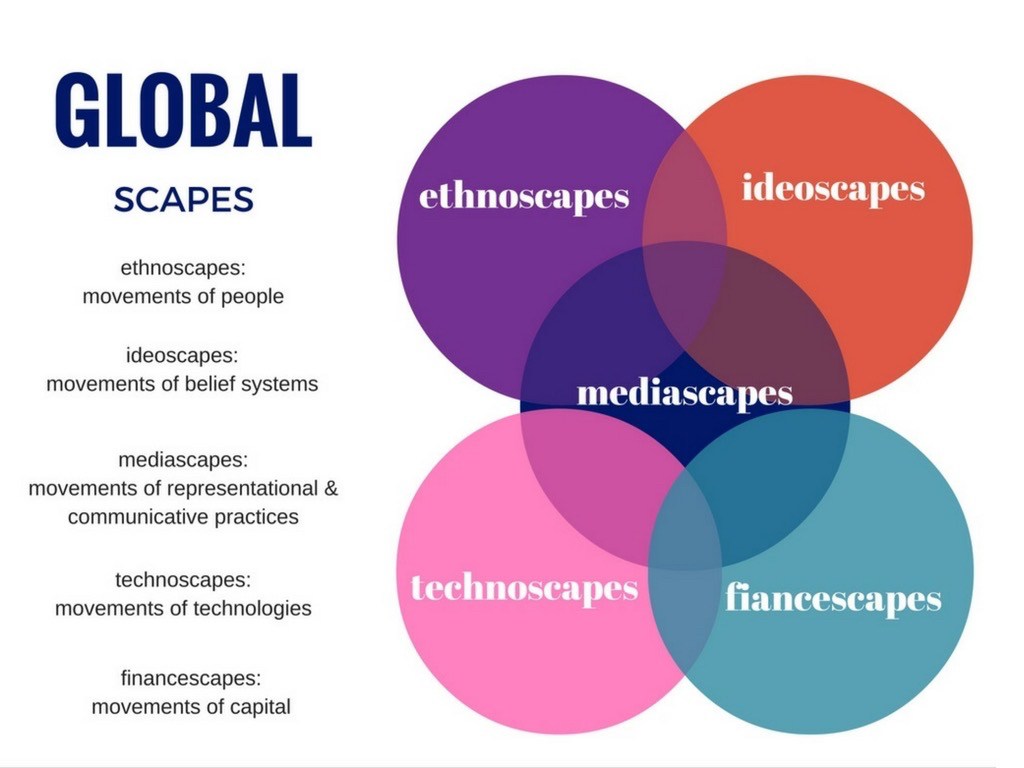
In his article, ‘Disjuncture and Difference’, Arjun Appadurai characterizes globalization as a system of articulations, or interactions, between global flows and local circumstances. This creates a ‘new global cultural economy’ that is complex, overlapping, disjunctive in order. This order is composed of different interrelated, yet disconected global cultural flows that he organizes into five categories he refers to as ‘scapes.’
- Ethnoscapes refers to the migration of people that brings new cultural forms across borders. It can include movements such as immigration, emigration, refugees, and tourism.
- Mediascapes refers to the flow of information that shapes the way people understand the world. It can include internet, newspapers, television, advertising, social media, books, and cinema.
- Technoscapes refers to the flow of technology, both mechanical and informational. This includes equipment as well as technical know-how.
- Financescapes refers to the worldwide movement of money and capital. This includes coins and cash as well as stocks and banking systems.
- Ideoscapes; the global flow of ideas and ideologies both political and individual. It can include ideas about “freedom, welfare, rights, sovereignty, representation, and democracy” and the social movements that promote them
These scapes are intertwined and interrelated. For example, new banking systems in the financescape rely on internet technology in the technoscape. Social movements in ideoscapes can be fueled by social media platforms in the mediascape. In addition, these scapes do not flow evenly across the planet, they each flow across global networks in distinct and uneven ways. Internet technology, for example, is not as accessible in rural areas as it is in urban areas. As a result, people living in urban areas are more connected to the techno, media, finance and ethnoscapes that flow on the internet technoscape than people living in rural and remote areas. Even among members in a single household, different experiences and engagements with various scapes can diversify lifestyles and opportunities according to an individual’s social positioning. The image below shows several family members living in the same extended household in a Moroccan village. Consider the different styled of clothing, livelihood practices and uses of different technologies in each image. On the far left, the tour guide spends his days in the ethnoscape of international tourism. His father, however, remain in the village and continue to engage in many of the same practices taking place in the village for hundreds of years. The woman on the far right speaks French and is married to a tour guide who earns income in the cash economy. She pursues a lifestyle similar to the global lifestyles displayed on the television programs she watched each day. The woman to the left married into the household from a remote village that does not have electricity. Although she did did not receive a formal education in a school, she is highly skilled in traditional agriculture, cooking techniques, and medicine.
In addition to uneven flows, global flows come into contact with local circumstances and articulate (interact) to generate new forms. Since local circumstances vary widely throughout the world, each articulation contributes to the development of a new form and creates a more heterogeneous cultural landscape. Today, many scholars are using the term glocal or glocalization to refer to the outcome of global and local interactions.
Glocalization in Africa
Culture in Africa has also been shaped by globalization processes. Global flows rooted in historical events such as early trade routes, colonialism, and modern international exchanges have shaped and continue to shape African culture today. This has led to the proliferation of cultural diversity in Africa as new cultural forms emerge throughout the continent through urban areas, digital technologies such as satellite television and internet, and the mas movement of diverse people in and out of Africa.
Coffee, for example, comes from the Arabic word Kahua قهوة , and the beverage has been widely consumed throughout the Middle East and North East Africa for many centuries. The global flow of European expansion through colonialism in the 15th century changed the ethnoscape in some parts of Africa, coffee plants were carried to the America’s and the cultural practice of drinking coffee spread throughout the colonized world. Yet, the global coffee flow articulated with different local customs in different European countries and colonies, and this led to the proliferation of many new cultural coffee forms; café au lait and latte (French), espresso and cappuccino (Italian), coffee (American), cuba coffee, chocolate-covered coffee beans, etc. American coffee has become one of the most widely consumed cultural forms of coffee on the planet, as the ancient Kahua beverage articulated with cafe culture in Seattle, and the transnational Starbucks Coffee Company carried American coffee culture into the urban centers of Africa. Review the coffee gallery below and watch the short film on Ethiopian coffee to see how globalization has created a heterogeneous coffee landscape.
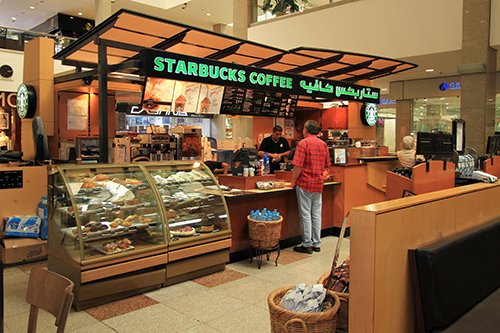
Starbucks in Cairo 
Moroccan coffee is often spiced with cinnamon and black pepper 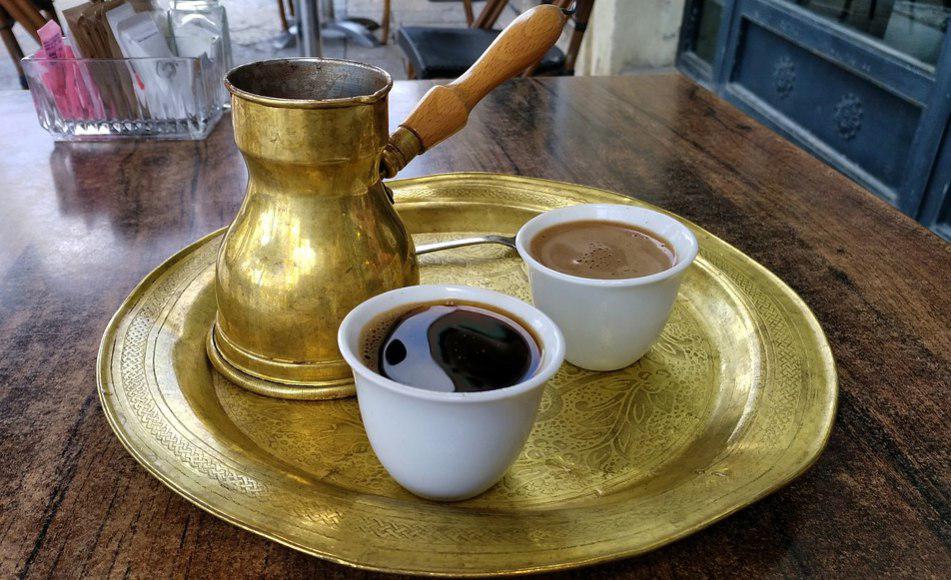
Egyptian coffee is sweet and foamy 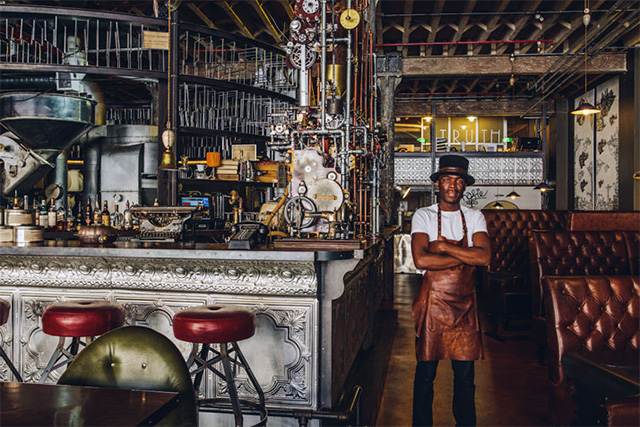
Steampunk-themed Coffee Shop in Cape Town, South Africa
Like coffee, globalization and diaspora has also shaped the musical landscape in Africa. The enslavement of African people in the Americas led to the development of new musical forms in the United States and influenced the development of gospel, jazz, blues and rock and roll. The Civil Rights Movement i the 1960s and 70s initiated the movement of rap and hip hop and the expression of African-American cultural experiences in the Americas. Through globalization processes, hip hop music made its way to Africa and merged with local African experiences to create a new form of African hip hop. Watch the documentary, Hip Hop Colony, and consider the ways that the global flow of American hip hop music merged with local circumstances. In what ways are the hip hop artists and songs similar and different to U.S. music from the same era?
Globalization and Diaspora in African Studies
Globalization and the African Diaspora is too complex of an issue to cover in a single webpage, but by now you should have a general idea of the way that globalization processes shape the experiences of people connected to Africa and how Africanisms have informed cultural practice in different ways through time (history) and across space (geography) throughout the world.
References and Resources
- Harvey, David. The Condition of Postmodernity: An Enquiry into the Origins of Cultural Change. Cambridge, MA: Blackwell, 1990.
- Massey, Doreen (1994). “A Global Sense of Place”. Space, Place, and Gender. University of Minnesota Press. ISBN 0816626162.
- “Globalization” Stanford Encyclopedia of Philosophy Analysis of the idea and its history.
- Mapping Globalization, Princeton University
- Appadurai, Arjun. 1990. ‘Disjuncture and difference in the Global Cultural Economy.’ Theory Culture Society 7; 295
- Akyeampong, Emmanuel (2000). Africans in the Diaspora: The Diaspora and Africa. African Affairs, vol. 99, no. 395. pp. 183–215.
Scholarly Articles for Future Research
For Discussion in Canvas
Present an example of the ‘glocalization’ of an African culturalism in Africa. Identify the global flow(s) and local circumstances that blended to create a new cultural form. What historical globalization processes occurred to produce the new form?

